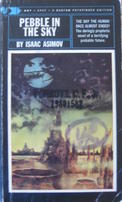
| Series: | Galactic Empire #1 |
| Publisher: | Bantam |
| Copyright: | January 1950 |
| Printing: | October 1964 |
| Format: | Mass market |
| Pages: | 200 |
I read Isaac Asimov's Foundation series long ago when I was first starting to read science fiction, plus the robots series, much of his short fiction, and several other novels. I never did read the Empire series, however, mostly because my local library didn't have it. When Asimov joined his future worlds together, the Empire sat in the middle between the robots and Hari Seldon, and Foundation only shows bits of the Empire in its prime. I was always a bit curious about it. After exhausting the library's Asimov collection, though, I moved on to other authors and have rarely returned to Asimov in the years since, but I did slowly accumulate all three Empire books and finally decided to try them.
The book opens with Joseph Schwartz, a retired tailor, walking along a street in 1949. Suspecting nothing, he's caught between one step and another by a side effect of a far future experiment and flung millennia into the future, to an Earth that's a despised backwater of a far-flung human galactic empire, a world whose surface is unpleasantly radioactive and which is ignored whenever possible. He's taken in by a farm family, unable to speak the language and doubting his own sanity.
Meanwhile, a renowned archaeologist from Sirius is visiting Earth to pursue his disregarded theory that humanity may have originated from a single planet rather than (as is the prevailing theory) evolving in parallel forms on many worlds. He's very open-minded for his world, feeling towards Earth and its inhabitants only a patronizing dislike rather than a more common revulsion. His path crosses with Schwartz's due to an experiment to enhance intelligence, for which Schwartz is unwittingly volunteered, and eventually they uncover a nasty plot.
Pebble in the Sky was Asimov's first published novel, predating the collection of Foundation into a novel by a year. Given that and Asimov's lack of stylistic grace even at his strongest, this is not a novel to read for writing excellence. The science is dubious at best, from Schwartz's hand-waving time travel to radiation that the natives of Earth become accustomed to but against which outsiders wear protection. There is, as was typical of science fiction at the time, some telepathy and mental powers mixed in with other forms of super-science. And the writing is wooden, sexist, and stilted in the average style of old pulp.
It is, instead, a curiosity, a bit of background material for Asimov's universe and a lesser work by a well-known master. In that light, it has a few interesting points, most notably the fairly sophisticated nature of the eventual plot and the reversal of the normal Earth-first style of gung-ho pulp fiction. These days, the idea of an Earth as a disregarded backwater has been used many times; at the time, it was more audacious.
Pebble in the Sky also has the pulp virtue of being mercifully short and reasonably tightly paced. It doesn't waste a lot of time getting where it's going, although Asimov's skill with exposition is as yet undeveloped and the story is occasionally derailed by "as you know, Bob" infodumps. But he packs a cultural adjustment, several very different perspectives, a bit of political intrigue, several technological ideas, and a somewhat cringe-inducing love story in a scant 200 pages. At least one need not invest much time to satisfy one's curiosity.
I can't recommend this book for any reason other than completeness. By an objective modern standard, it isn't very good. It's a rough early novel without the spark of brilliance that makes, say, The City and the Stars still worth reading. But neither is it dire; if one wishes to indulge one's curiosity, it is occasionally mildly entertaining.
Reviewed: 2008-10-18